|
|
Post by Bruce on Jun 4, 2017 17:35:09 GMT 12
Note how many aircraft have had the access flap on either side of the cowls replaced? Yep C180 Oil filler cover flaps are pretty lightweight. When (not If) the Hartwell latches break they'll just disappear in the slipstream! later models had smaller doors and more substantial latches. |
|
|
|
Post by Peter Lewis on Jun 4, 2017 17:59:23 GMT 12
Cessna 180 ZK-BUX was registered to Rural Aviation on 10Oct1956, having arrived as N9724B. It started work as an agricultural aircraft straight away, and remained within the operation fleet until the 180s were replaced by 185s in the early 1960s. ZK-BUX moved to Australia, with the NZ registration being cancelled on 20Sept1963. In Australia it took up life as VH-BAI with Booroowa Airwork, and in October 1964 moved to Hazelton Air Services, finally being sold into private ownership two years later.
ZK-BUX at Bell Block on 1Mar1958.
Obviously some sort of crowd-attracting event took place on that day. Any ideas? ZK-BUX starting up at Wanganui in May 1961 ZK-BUX starting up at Wanganui in May 1961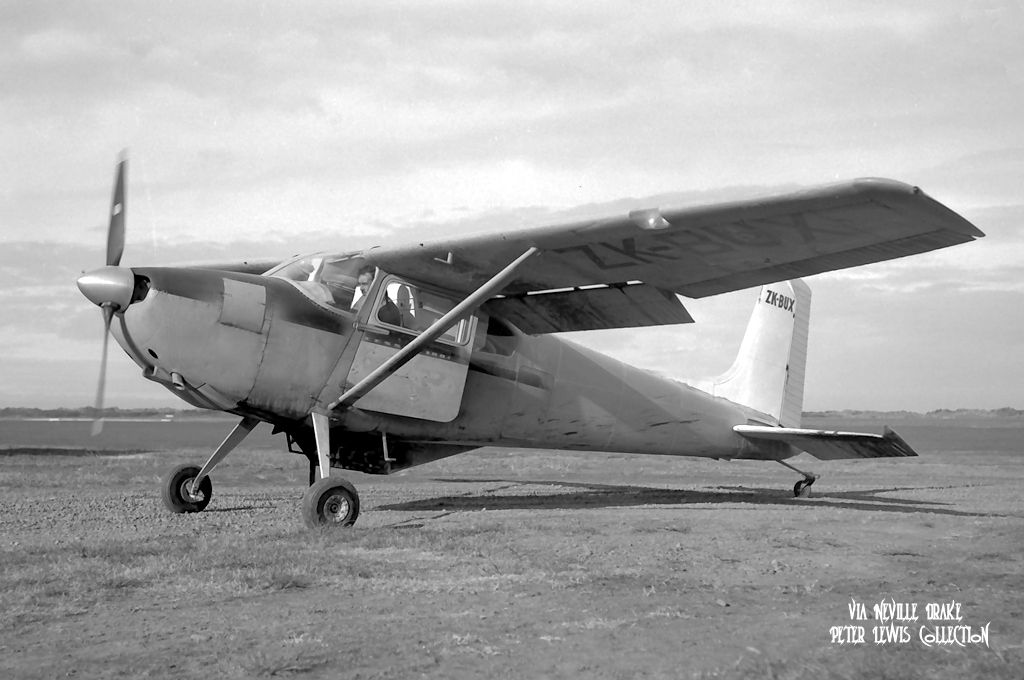 Rigged as a sprayer, looks to be at Feilding? Rigged as a sprayer, looks to be at Feilding?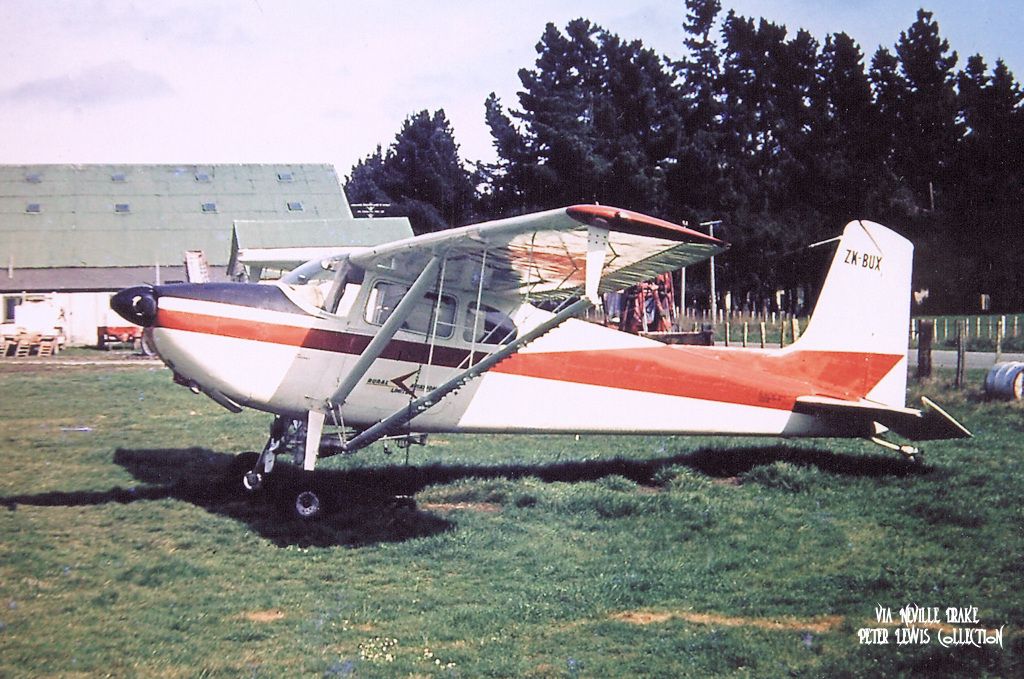 |
|
|
|
Post by delticman on Jun 4, 2017 18:12:44 GMT 12
The colour shot is Masterton, the old Air Contracts hangar in the background.
|
|
|
|
Post by Peter Lewis on Jun 5, 2017 18:11:46 GMT 12
N9723B was allocated at the factory to a Cessna 180A which arrived new in NZ for Rural Aviation. Registered as ZK-BUY on 10Oct1957, it then went into their operational fleet. On 15Dec1961 it was badly damaged at Lumsden, in Southland, when the aircraft overran the airstrip on landing and crashed through a fence into a gully. ZK-BUY parked at Waipukerau in January 1959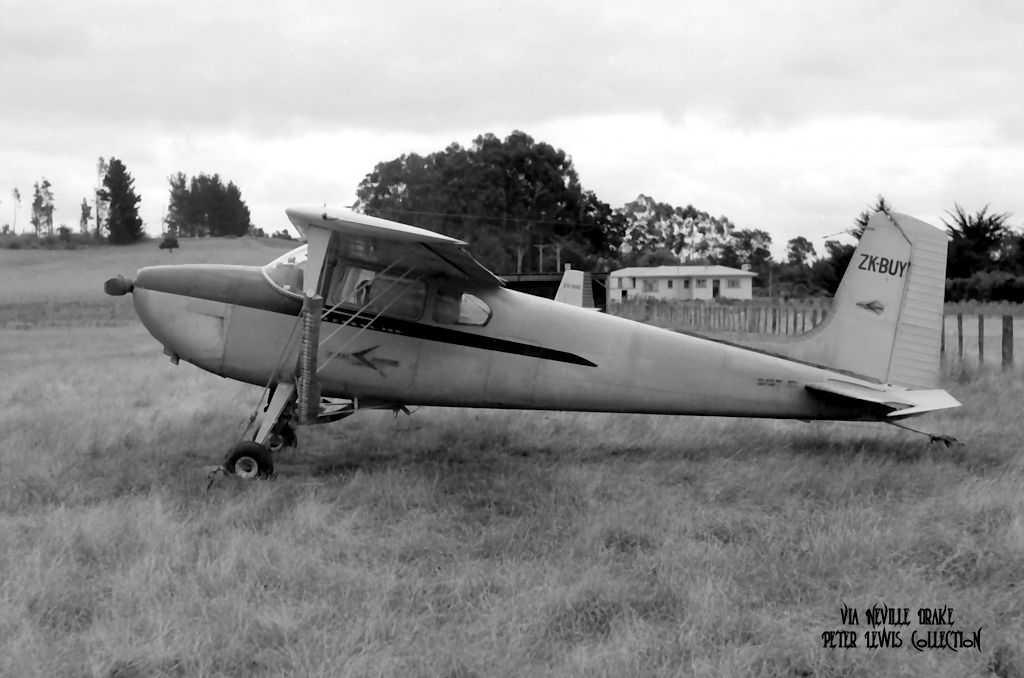 and at Paraparaumu in July the same year 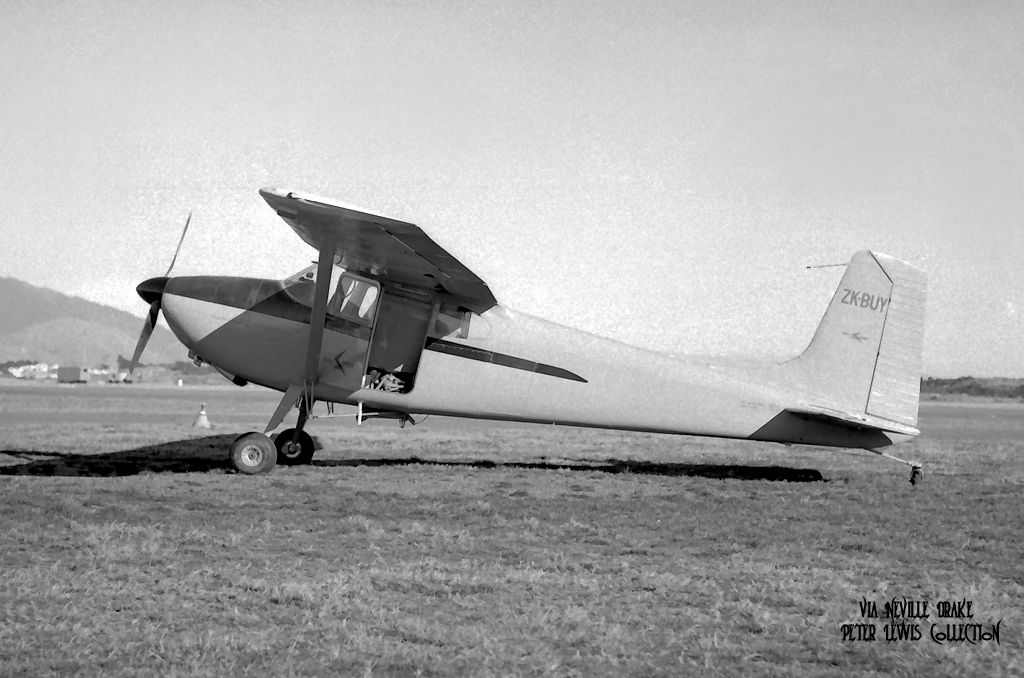 The remains were gathered up and returned to the Rural Aviation workshops at Bell Block. There, the aircraft was rebuilt, incorporating many other new and used parts. The resulting 'bitsa' appeared in March 1962 as ZK-CBL with the new c/n RA.3/62, reflecting its mixed parentage. In the following month it was taken south to join the fleet of Southern Scenic Air Services. It apparently operated as a floatplane during its time with SSAS, and was destroyed in a fatal crash immediatly after t/off at Lake Shirley 4Mar65, Pilot Alan Nicholas and one passenger killed, second passenger survived. The wreck was recovered in Jan1973. 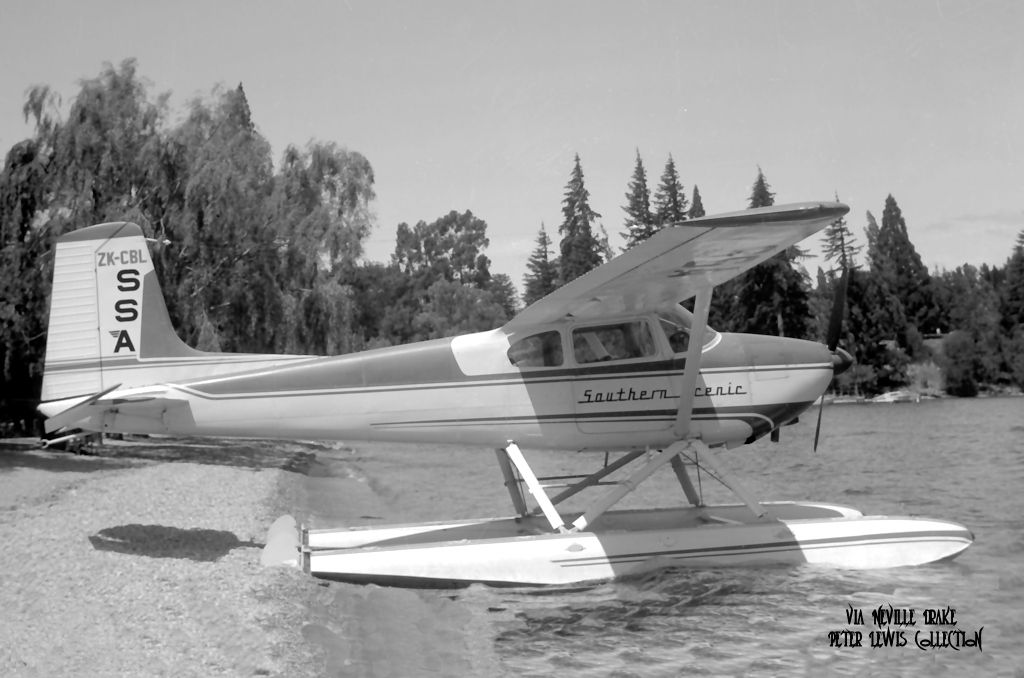 |
|
|
|
Post by Peter Lewis on Jun 6, 2017 20:40:51 GMT 12
Cessna 180 N9746B arrived to become ZK-BVD with Rural Aviation on 22Nov1957. Initially operated as a four-seater, this 180 was fitted with amphibious floats - probably those off ZK-BLL - and then leased to the Fred Ladd managed company NZ Tourist Air Travel Ltd. at Auckland from January 1958. This aircraft was not a success on this type of harbour and gulf operation. The lease was terminated in April 1958, the aircraft returned to Rural and put back on wheels. ZK-BVD was then converted for agricultural ops and joined the Rural operation fleet until being sold to Central Aviation Ltd., of Roxburgh where it was similarly employed. It was withdrawn from use in January 1969 (possible accident?) and passed across to Southair Aviation Services at Dunedin where it was rebuilt as a four-seater incorporating Robertson STOL mods. First flight after this rebuild was 24Jun1970 and the aircraft then passed through a number of other owners before being exported to South Africa in 2010 where it became ZS-NZD. ZK-BVD on floats at Mechanics bay early 1958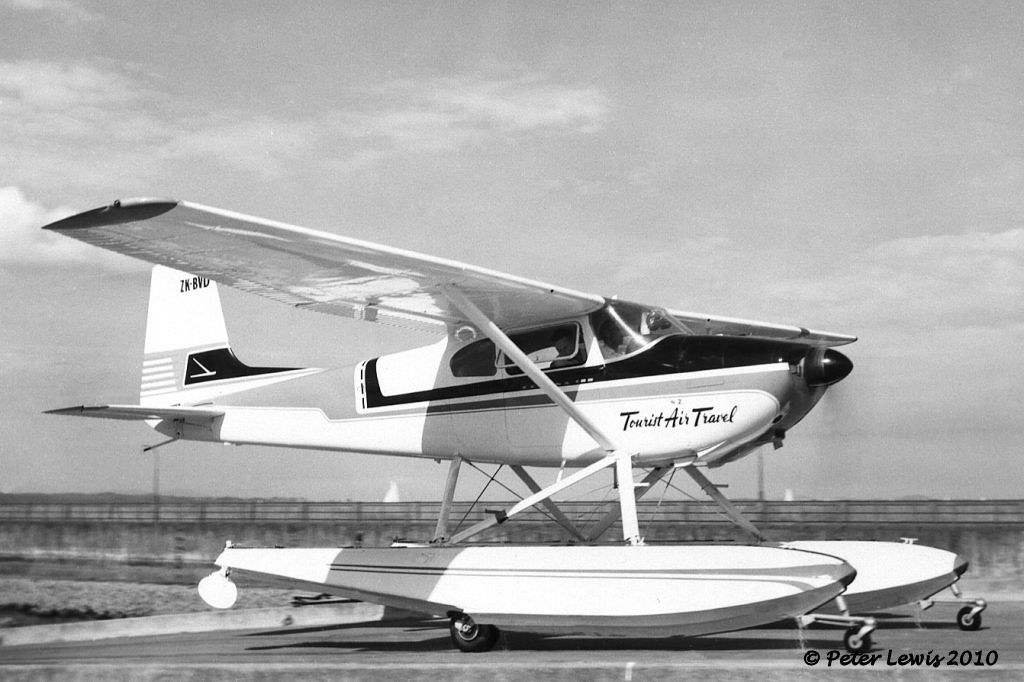
Outfitted with a spray rig, ZK-BVD at Bell Block 1959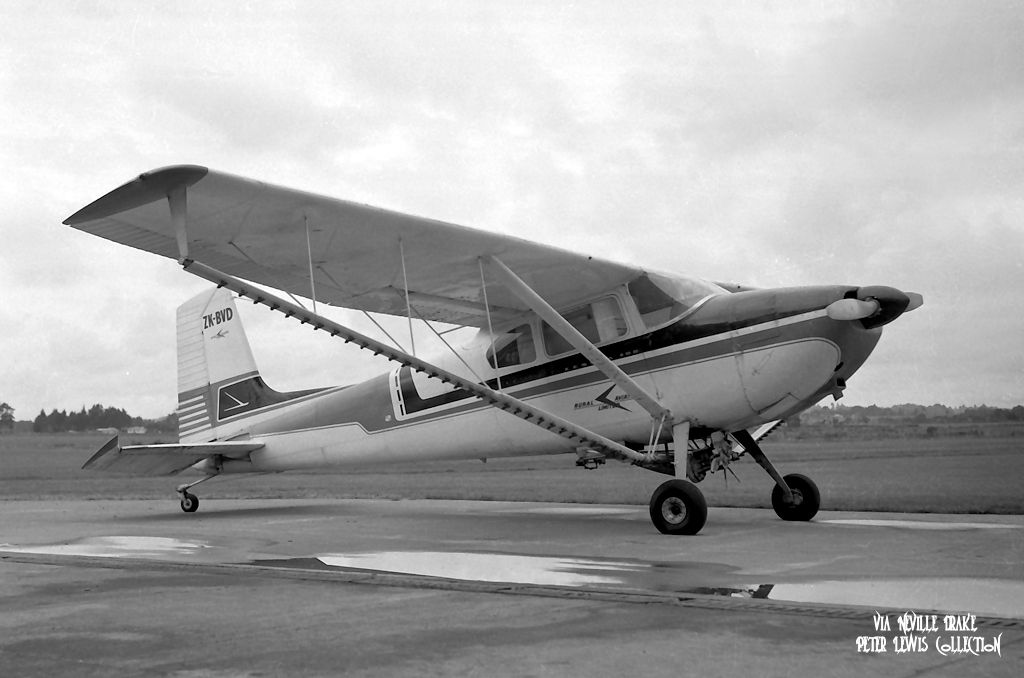 Looks to ba a fairly slow way of filling the spray tank compared with the system shown previously for ZK-BUG Looks to ba a fairly slow way of filling the spray tank compared with the system shown previously for ZK-BUG |
|
|
|
Post by Peter Lewis on Jun 7, 2017 17:41:27 GMT 12
James Aviation (Rotorua) Ltd. bought a new Cessna 180A from Rural Aviation in March 1958. This aircraft had arrived new from the factory as N9770B and had been registered as ZK-BVG to Rural Aviation as agents on 28Nov1957. James used ZK-BVG within their scenic and charter divisions until a sale to the Rotorua Aero Club in August 1965. It moved on to ther private owners in later years. There was no agricultural use. Cessna 180A ZK-BVG at Ardmore 29Jan1966, not yet had the James name removed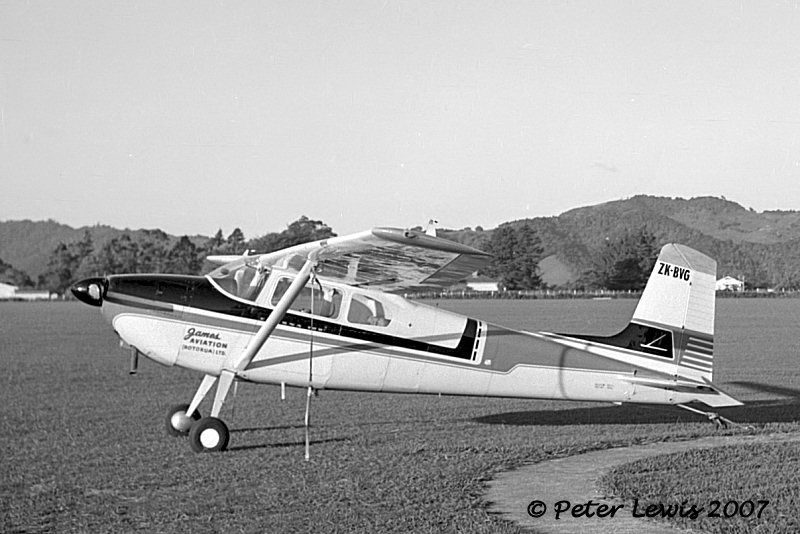 |
|
|
|
Post by Peter Lewis on Jun 7, 2017 17:46:33 GMT 12
Cessna 180 N9243C was built in 1955 and saw use in the USA before arriving here in 1958 as a used import for Petersen Aviation who were based in Napier. It became ZK-BVQ in their name on 10Mar1958. Although moving on to Cookson Airspread in July, this 180 was used for that company's charter and freight operations rather than for any agricultural work. It later formed part of the Golden Coast Airways fleet before being taken to Australia in 1964 where it became VH-BVQ. Cessna 180 ZK-BVQ in Cookson colours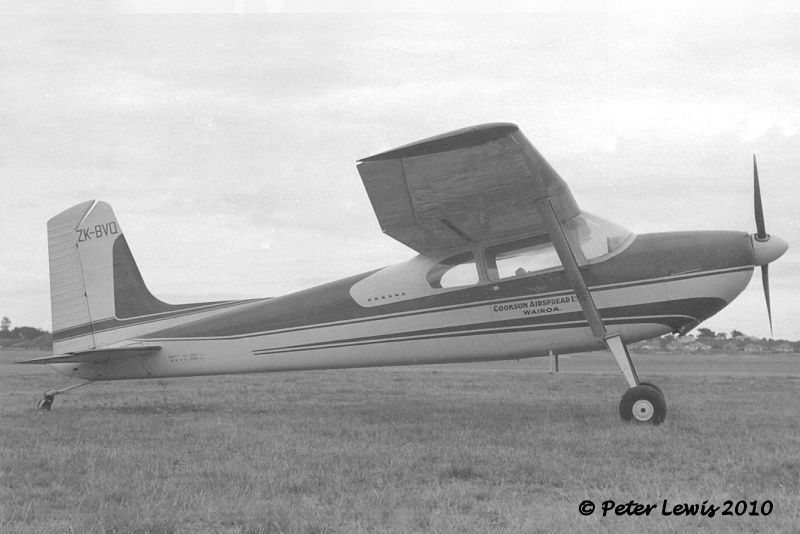 |
|
|
|
Post by Peter Lewis on Jun 8, 2017 14:07:36 GMT 12
N9329T was the first Cessna 180C (230 hp (172 kW) Continental O-470-L or O-470-R) to arrive. New from the factory it was registered as ZK-BVV to Rural Aviation on 31Jun1960. In May 1962 it went south to Aerial Sowing (Canterbury) Ltd. based out of Christchurch, and in March 1964 that year moved even further south on lease to Central Aviation at Roxburgh. Central did not keep it long, for in October it was on the books of the newly-established Cessna agents Rex Aviation, who had been establish at New Plymouth to separate the aircraft dealership side of things from Rural Aviation's operational activities. Rural Aviation took ZK-BVV on again on 17Dec1964, and then it moved to Airspread (Taranaki) Ltd. at Stratford in September 1967. It finally moved out of agricultural work when sold back to Rex Aviation in March 1968 and then passed on to private ownership. ZK-BVV is still current, and based in Tauranga. Cessna 180C ZK-BVV parked at Bell Block in November 1960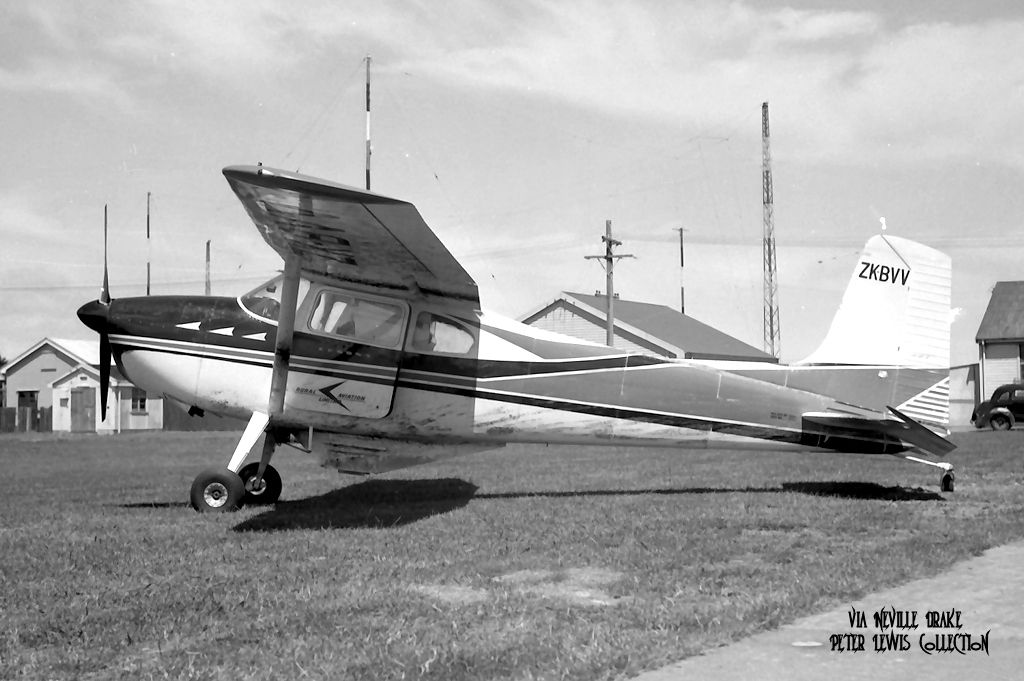 Having been south and returned, ZK-BVV now repainted at Bell Block 3Mar1967 Having been south and returned, ZK-BVV now repainted at Bell Block 3Mar1967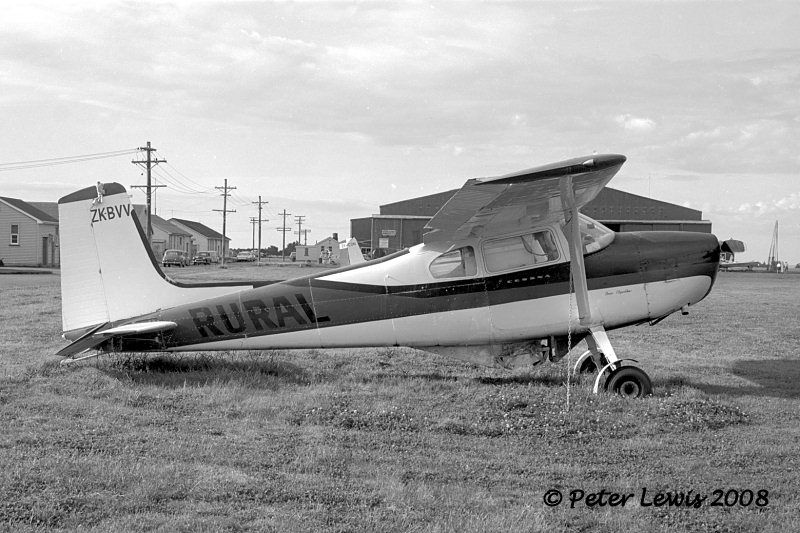  |
|
|
|
Post by eieio on Jun 8, 2017 19:46:58 GMT 12
BVG ,was this the aircraft Fred Ladd put down on a ridge with an oiled windscreen . BVG was on floats and had an argument with the control gates at Taupo . I was told the current BVG contains little of the original. James used it for dropping supplies to Forest service deer cullers in the Ureweras among other jobs
|
|
|
|
Post by Peter Lewis on Jun 9, 2017 10:53:24 GMT 12
Cessna 180C N9328T became ZK-BVW with Rural Aviation on 31May1960. After three years working for Rural, ZK-BVW moved up to Te Kuiti in April 1963 to join the Northern Air Services fleet. On 9Feb1965 the aircraft was destroyed at Te Kuiti when it collided with a fence strainer post on take off and overturned in scrub. Presumably this was at a local farm strip rather than the airfield. ZK-BVW while online with Rural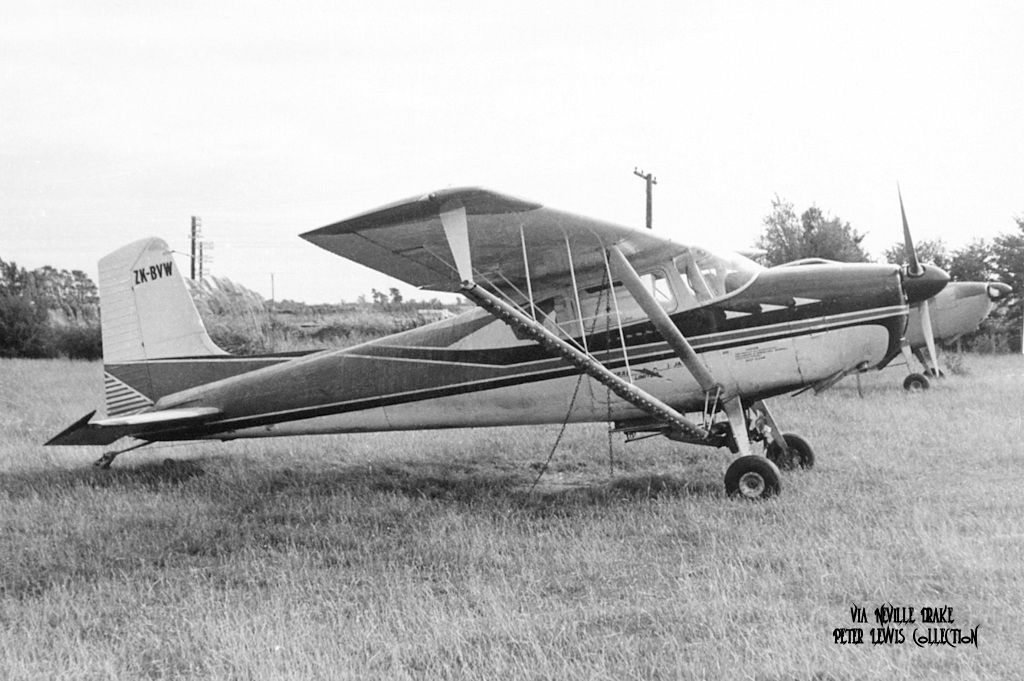 At Northern Air Services home base, Te Kuiti At Northern Air Services home base, Te Kuiti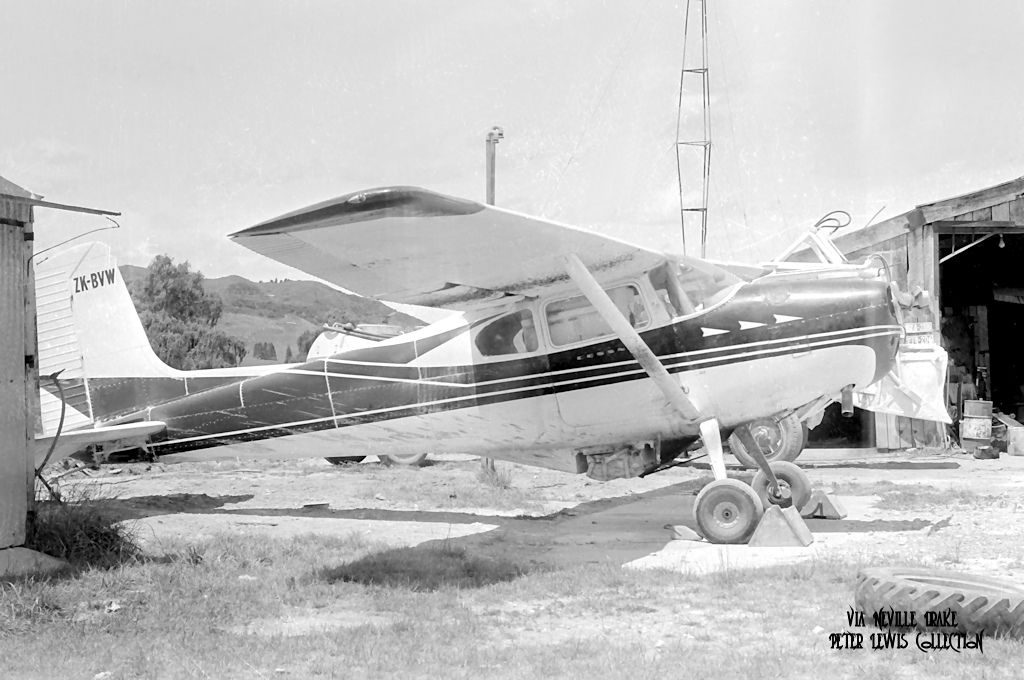 |
|
|
|
Post by gustav10 on Jun 9, 2017 11:16:22 GMT 12
15 hours ago
Quote like
Post by eieio on 15 hours ago
BVG ,was this the aircraft Fred Ladd put down on a ridge with an oiled windscreen . BVG was on floats and had an argument with the control gates at Taupo . I was told the current BVG contains little of the original. James used it for dropping supplies to Forest service deer cullers in the Ureweras among other jobs
The aircraft you refer to was 185 ZK-CFE. The prop dome screws broke, the dome parted company and the pitch went to zero. Flying stopped at that stage......
BVG was torn from its mooring
s at Taupo and scrambled downstream, hence the lack of original parts.
|
|
|
|
Post by Peter Lewis on Jun 10, 2017 9:53:41 GMT 12
Rural Aviation imported the next Cessna 180C as N9246T and registered it as ZK-BVX on 31May1960. After operating in the Hawkes Bay and Southland/Otago areas for Rural, this aircraft was damaged beyond repair when it overturned on landing at Balclutha 2Aug63.
ZK-BVX fairly new at Bell Block in November 1960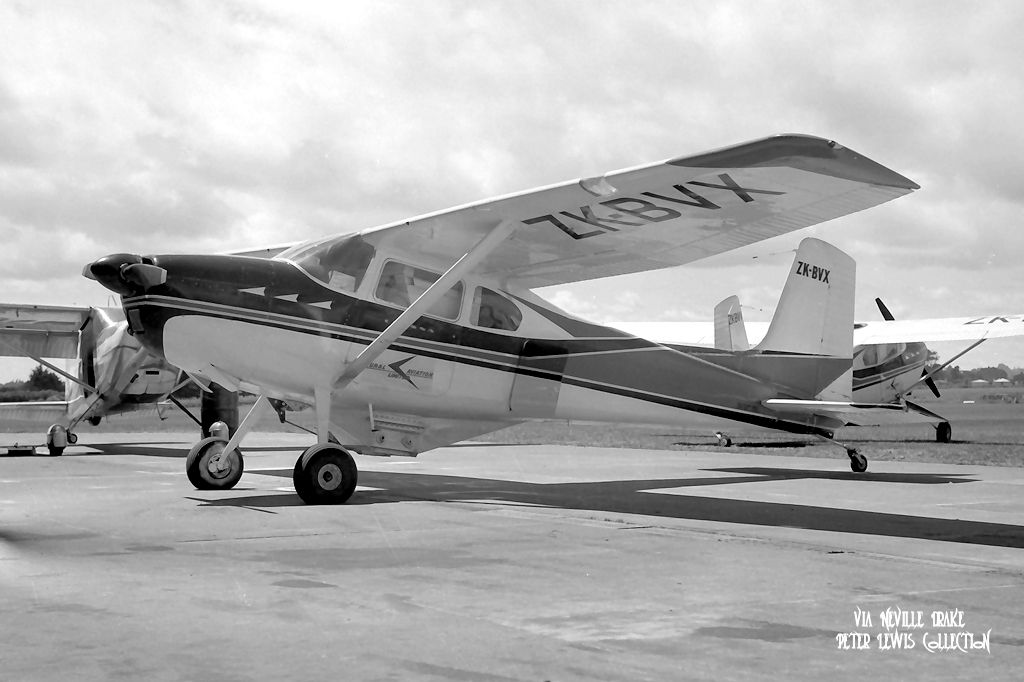 ZK-BVX not so new, Balclutha August 1963 ZK-BVX not so new, Balclutha August 1963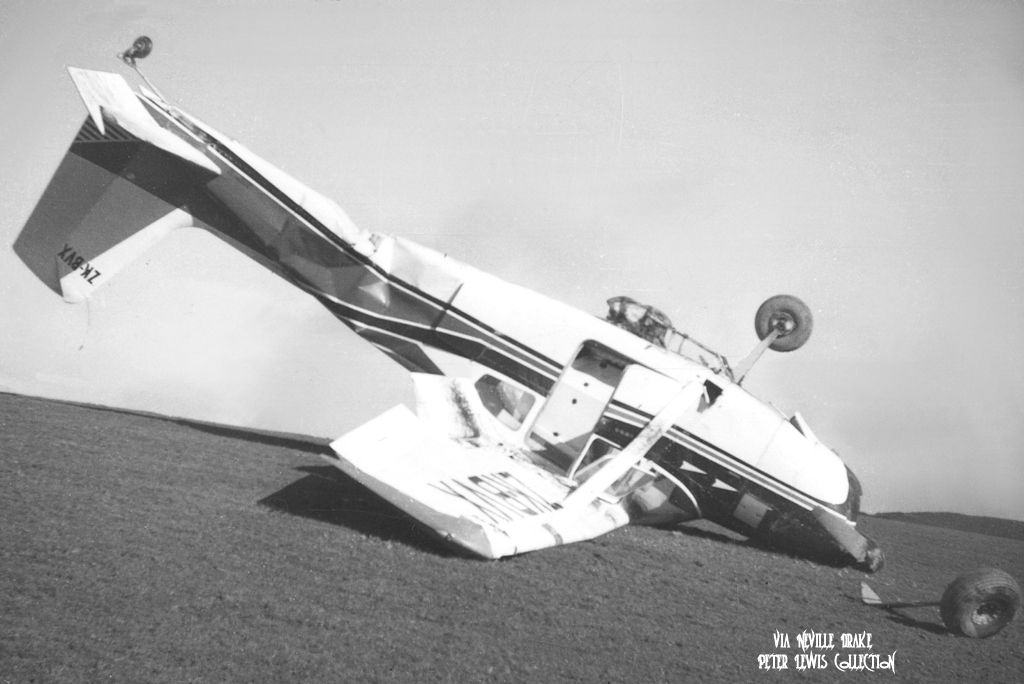 |
|
|
|
Post by Peter Lewis on Jun 10, 2017 17:46:01 GMT 12
After the Vanair C180 ZK-BGN crashed at Putorino on 1Apr55 the remnants were eventually taken back to the Rural Aviation workshops at Bell Block. Over time, these were incorporated into a bitsa rebuild along with various other new and used parts and the result finally emerged in March 1960 to be registered as ZK-BWK with the c/n RA.2/60 On completion, the aircraft was flown south into the care of Auster Air Services at Timaru. They took ownership on 6April1960. On 9Sept1963 ZK-BWK moved to Aerial Sowing (Canterbury) Ltd., Christchurch, and stayed with them until moving into private ownership on 23Dec1966. As has been pointed out already, on 24Feb1968 ZK-BWK was flown across to the Chatham Islands inside a Safe Air Bristol Freighter. It was then employed freighting crayfish from Pitt Island to the main Chatham Island to allow them to be prepared for export. ZK-BWK was returned to the NZ mainland later that same year. It was eventually destroyed in a a takeoff crash at Esk Heard Station, North Canturbury, 2Nov2013. ZK-BWK of Auster Air Services at Harewood (Christchurch) April 1961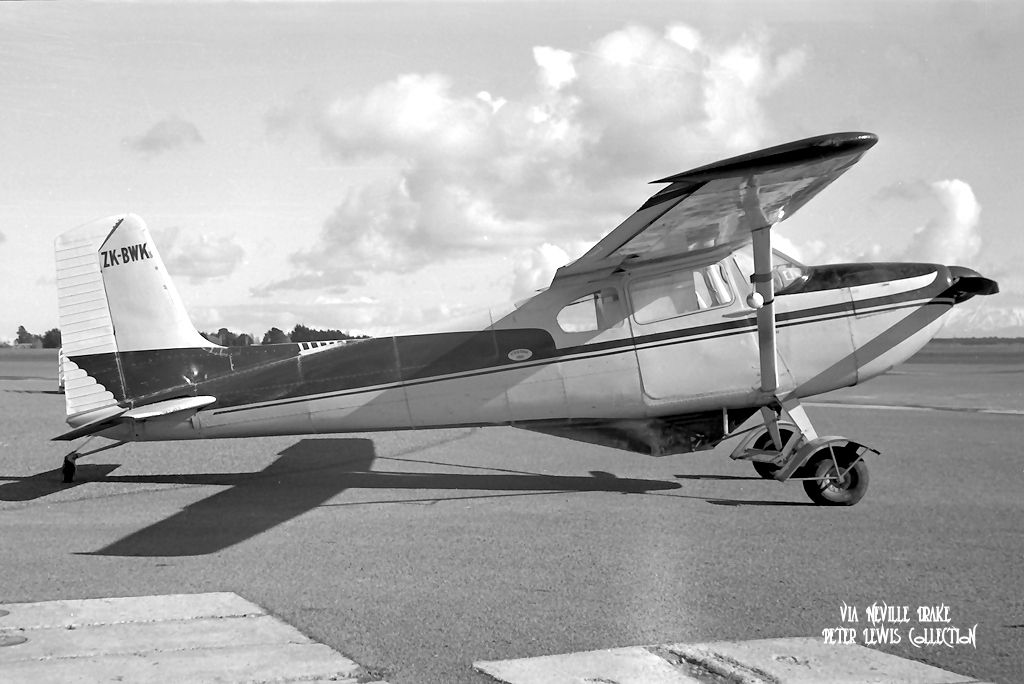 |
|
|
|
Post by chinapilot on Jun 10, 2017 18:08:31 GMT 12
Great thread enhanced by Peter.
We owe a lot of thanks to Neville Drake who not only was a avid aviation enthusiast, but also encouraged the younger 'aviation mad' generation back in the '60s.
|
|
|
|
Post by Peter Lewis on Jun 10, 2017 18:47:54 GMT 12
Contrast that with CAA/Avsec who now do their (taxpayer funded) best to discourage.
|
|
|
|
Post by thomarse on Jun 10, 2017 19:24:26 GMT 12
Great thread enhanced by Peter. We owe a lot of thanks to Neville Drake who not only was a avid aviation enthusiast, but also encouraged the younger 'aviation mad' generation back in the '60s. Tell me more about Neville, Ian - not a name I know |
|
|
|
Post by davidd on Jun 11, 2017 10:38:44 GMT 12
That photo of BWK at Harewood in 1961 is of interest to me in that the small oval badge on rear fuselage aft of the rearmost window is a complete surprise. Does it state "Cessna 180" or is it something completely different. Incidentally I would not dispute ownership of aircraft at the time, but so far as I know this aircraft was permanently based at Amberley in those very early years, although it is possible that its notional base was at Timaru. Perhaps Amberley was an "advanced" base during the topdressing season for undertaking all jobs in the North Canterbury area, as opposed to South Canterbury area. There must have been some sort of relationship between Auster Air Services and Aerial Sowing (Canty) Ltd. The scheme shown here is of course the original dark blue and cream one, although as I remember it (and have colour slides of it somewhere - need to check them), there are several small but noticeable differences in the paint scheme, apart from the oval badge already mentioned, including the detailing of the rudder decoration as well as the diagonal stripes on the forward part of the fin fillet. Those rather outrageous mud guards (true function, as with all aircraft operated off farm strips, best described as cow and sheep dung suppressors) were also a feature for a while, but I think were later removed. Have checked the negatives from the Des White collection, and there were actually THREE completely different colour schemes for this aircraft, all while equipped with the hopper, which corrects my previous statement that there were only two. One thing that has struck me on this thread is the completely different appearance of this aircraft type, apart form the obvious cowling differences, is the size of the wheels/tyres fitted. With the small wheels they look somewhat effeminate (and no, I will not argue this point!), but with bigger wheels (not to be confused with modern tundra tyres) they really look the business.
David D
|
|
|
|
Post by Peter Lewis on Jun 11, 2017 11:32:37 GMT 12
That photo of BWK at Harewood in 1961 is of interest to me in that the small oval badge on rear fuselage aft of the rearmost window is a complete surprise. Does it state "Cessna 180" or is it something completely different. David D Cessna 180 |
|
|
|
Post by The Red Baron on Jun 11, 2017 12:42:43 GMT 12
Auster A/S owned Aerial Sowing and Willmotts and Potters but continued to present them as a seperate entities and they traded planes and pilots between companies as demand dictated.
|
|
|
|
Post by davidd on Jun 11, 2017 13:02:16 GMT 12
Red Baron,
Thanks for confirming that, having read this entire thread (over time!) it is obvious that these sort of arrangements were hardly unusual. Would I be right in thinking that the licensing system often had a lot to do with this sort of behaviour?
Dave D
|
|

